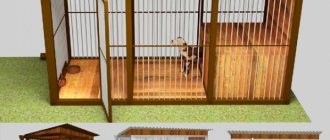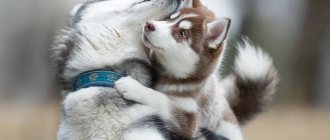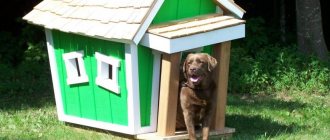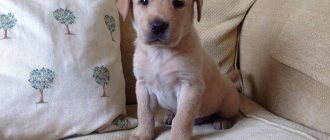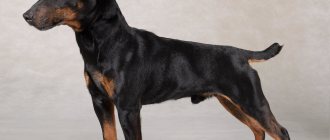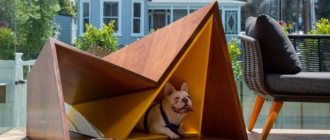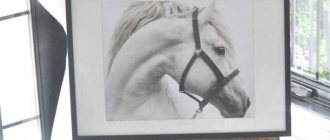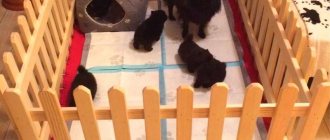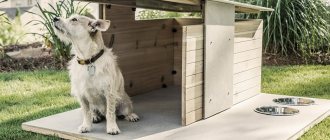Types of enclosures
Before you start building an enclosure, you need to choose its type, type and size. The choice depends on the size, age and sex of the animal, construction materials and other factors. Enclosures are divided into 2 types: outdoor and indoor.
Shepherd dogs feel cozy in the winter enclosure
Outdoor enclosures
Outdoor options are most often used for medium to large dogs with long hair, such as a Rottweiler or German Shepherd. Such designs are intended for:
- restrictions on the walking area;
- organizing your own space for your pet;
- animal protection;
- simplifying training.
Note! The enclosure limits the space through which a dog can move outdoors. This allows you to preserve the beds in the garden and plants in your private area. This is also convenient when guests visit, when a large dog can scare people unfamiliar to it. In addition, in a confined space, a dog can more easily learn commands and be trained.
An outdoor enclosure, in turn, can be of 3 types:
- temporary. Inexpensive option. Usually used in the summer at the dacha or to temporarily house a dog. For manufacturing, a mesh or fence is used. A booth is placed inside the fence or flooring is made;
- closed. An intermediate option between temporary and permanent enclosures. A closed pen is used for long-term stays of dogs. It consists of walls, flooring and roof. At least one wall must be made of mesh (lattice) so that the dog has an open view;
- capital. It consists of two zones: a lattice part for walking and feeding, as well as a closed seating area. Suitable for year-round maintenance. The building must be insulated on all sides for a comfortable stay for the dog in the winter.
Any design must contain a walking area appropriate for the size and temperament of the pet. This should be a fenced area, not cluttered with things. The dimensions of the walking space are calculated so that the dog can move freely. The dog should have open access for walks at any time.
Important! To protect from precipitation, they make a canopy or roof, because the dog cannot stay in a small booth for a long time.
Home enclosures
This design is used for:
- increasing the safety of puppies in the apartment;
- organizing your pet’s personal space in an apartment;
- protection of furniture and other household items from damage by a pet;
- demarcation of housing when a baby or other animals appear in the house.
Small pets need their own space too
A budget playpen will give the female who has given birth a sense of security. It will also help keep furniture, shoes and other items safe, protecting them from damage from the teeth and claws of animals.
For your information! When other pets or a small child appear in the house, the dog may react aggressively. The enclosure will help the dog get used to the arrival of a new tenant.
Typically, such a dog enclosure is a folding mesh fence or a large cage. The net is used for small puppies who will not be able to get out. Cells limit space not only from the sides, but also from above. They are used for adult small dogs. Inside, areas for resting and feeding are organized, and a tray is placed.
Metal, wood or plastic are used as materials for a home enclosure. The design is chosen according to the size, needs and number of pets. Assembling such a pen is quite simple.
Varieties
The main classification allows you to divide structures according to the place of application:
Outdoor enclosures
They are used for permanent or temporary maintenance of large and medium-sized breeds, mainly long-haired ones.
Buildings for permanent use are made permanent, with solid walls and small inserts of mesh or lattice. As a rule, such structures are additionally heated to make them comfortable in winter.
As for seasonal buildings, such outdoor dog enclosures are more often used in the summer, for example, on a site where a family and their pet come for the summer.
Regardless of the frequency of use, it is necessary to take care of the availability of walking space, the size of which depends on the temperament and size of the dog.
Home enclosures
They are necessary for the safe keeping of puppies, creating a corner for the dog, and demarcating the territory of a house or apartment when a small child is born.
The simplest designs are made in the form of a folding fence, and products in the form of a cage provide maximum safety.
Inside there is a pet bed or kennel, but if there are puppies inside, you will also need to place a tray there.
General requirements and standards
Before building an outdoor enclosure for a dog with your own hands, you need to prepare a project and complete the correct drawing. It is not necessary to make a professional image, just follow the diagram. The main thing is to display the main points on it: overall size, delimitation of zones, size of the booth, walking area, places for feeding and resting.
Do-it-yourself enclosure for a husky: drawings and dimensions
Basic requirements for the enclosure:
- To prevent the dog from being injured, all objects should be secured well and the surfaces should be thoroughly sanded. There should be no gaps in the enclosure through which the dog can get out;
- when keeping two or more dogs at the same time, it is recommended to delimit the space with partitions so that the animals do not conflict;
- materials for building an enclosure must be durable, resistant to mechanical and climatic influences;
- The height of the enclosure must correspond to the size of the dog. A roof that is too low will have a negative moral impact on the pet;
- Inside you need to place feeders, containers with water, a booth or a covered room for rest.
Note! Husky dogs are hyperactive. They need to provide a large walking area. The minimum size of the fence is 10 m². For raccoon dogs, reliable fencing is required at the top and bottom to prevent the possibility of undermining.
Huskies love a large walking area
What should it be?
The main requirement for building an enclosure is as follows: remember that you are building a house for your dog and it should be comfortable, cozy and calm.
In the enclosure, the dog should feel warm and dry. After all, the dog not only sleeps or eats there. He also plays there, rests, and guards the territory.
Your dog should have plenty of room to move around inside the enclosure, so:
- an enclosure for a beagle, spaniel, shiba inu or other medium breeds no more than 50 cm at the withers, the area must be at least six square meters;
- an enclosure for a husky or Labrador , as well as other dogs whose height at the withers reaches 65-70 cm, you need to build an enclosure with an area of at least eight meters;
- the enclosure for a Caucasian or Central Asian Shepherd Dog , Alabai should be very large: at least ten square meters. Preferably more.
We have decided on the size of the area. What about the gender of the animal?
The requirements for a bitch and a dog are completely different. A female individual needs a maternity room and a vestibule, which will be located in the enclosure.
It should be protected as much as possible from bad weather, because the bitch will give birth to puppies and they will not be in the kennel, but will begin to move around the entire area for their games.
A male dog needs a large and reliable kennel; he is physically strong and strong. A large and strong male is able to knock out a lock or break an enclosure, so he must be strong.
Requirements for materials for construction
DIY dog house: drawings and dimensions
The construction of a dog enclosure is carried out in several stages. Each specific part of the structure is made separately from a specific type of material:
- the foundation is usually poured from a cement-sand mixture and reinforced with metal reinforcement;
- the floor is made of concrete or wood. It is necessary to make a flooring on top of the concrete, since the covering is bad for the joints and claws of dogs. In both cases, wooden boards are sanded, treated with antifungal substances, and varnished. The coating must be resistant to moisture and safe for the animal;
- Solid walls and partitions are made of wood. Suitable materials include lining, boards or sandwich panels. The wall for an open view in the walking area is made of chain-link mesh, profile pipes, metal pipes or forged elements. When choosing materials, you should pay attention not only to cost, but also to think about the safety of the dog. A mesh covering is cheaper than metal rods, but if a dog tries to chew through it, it can damage its teeth;
- It is better to make the roof from a soft, lightweight material that will not create loud noise and frighten the pet during precipitation.
Location
Task No. 1 when choosing the location of the future enclosure is to ensure maximum visibility of the territory under the dog’s control. And task No. 2 is to remove this structure from possible sources of strong odors . There are “scents” that you don’t have to be afraid of - this is amber from a poultry house or from a barnyard, the dog can easily sniff them. But the constant ammonia smell will quickly weaken the capabilities of his nose. There are also fragrances that are completely harmful to a dog’s health, and you should stay as far away from them as possible.
When installing the enclosure, there is no need to navigate by the cardinal points or the direction of the winds. But if a pen is being built for a northern dog (husky, samoyed, husky, etc.), then it would be more correct (if there is such a technical possibility) to turn it with its façade to the north. An animal from the south (Caucasian Shepherd or Central Asian, for example), will be more comfortable living “facing” its native latitudes, that is, to the south.
Important! If there are blank walls near the enclosure, it is better when they stand against the movement of the prevailing winds in the area.
Tools and material calculation
DIY enclosure for alabai: dimensions
To build an enclosure, you will need standard construction tools, such as a shovel, hammer, drill, hacksaw, adjustable wrench, welding machine, and pliers. To weld the frame, you may need the help of a professional.
Note! Materials for construction may vary depending on the chosen design, personal preferences and the availability of available parts on the farm. The amount of materials is determined by the size and design of the enclosure.
When building an enclosure for a medium-sized dog, you will need (area 2x4 m, wall height 2.5 m):
- brick - 400 pcs.;
- welded mesh height 2.5 m - 8 m;
- dry cement (3×25 kg);
- metal pipe 3 m high and 20 cm in diameter - 4 pcs.;
- wooden board - 16 m²;
- varnish - 1 jar;
- slate - 8 m²;
- roofing felt - 8 m²;
- nails and screws;
- metal door frame with hinges;
- insulation material (expanded polystyrene, mineral wool);
- sand and fine stones.
Approximate drawing of a two-zone enclosure with an area of 2×4 m
Calculating the size of an enclosure for a dog
A small area of 6-8 m² is suitable for a temporary enclosure. A permanent enclosure for a dog should be larger and more thorough.
Important! There is no need to save space for an enclosure. Insufficient space will affect the dog's health. But you shouldn’t swing it too much, because in the cold season a small space retains heat better.
The area of the enclosure is determined by the height of the dog at the withers:
| Dog height, cm | Enclosure area, m² |
| 45-60 | 6 |
| 50-65 | 8 |
| more than 60 | 10 |
You should also consider your pet's physical activity.
For small but restless huskies, you should build an enclosure with an area of at least 15 m², and for the calm giant mastiff, an area of 11 m² will be enough. Note! The area of the enclosure for two dogs should be increased by 1.5 times. The same should be done if a female with puppies will live in the enclosure.
Choosing the optimal location for construction
First of all, you need to choose a place where to build a dog house. It is worth paying attention to the following recommendations:
- the noise level should be minimal;
- the entrance door of the enclosure must be within sight;
- it is better to build an enclosure on a flat area or hill, where moisture will not accumulate after precipitation and there will be a good view;
- You should not place the enclosure near the toilet or other sources of unpleasant odors, as this will negatively affect your pet’s sense of smell.
How to build an enclosure for a dog on a site with your own hands
The construction of the enclosure consists of the following stages:
- Preparing the foundation.
- Frame installation.
- Floor covering.
- Walling.
- Roof installation.
- Connecting communications (lighting, heating - if necessary).
- Door installation.
Note! Before bringing your dog into its new home, you should carefully inspect all internal surfaces for sharp corners and check that feeders and other elements are securely fastened. You should also make sure that the door is locked securely.
Arrangement of a site for an aviary
The area for the enclosure should be level so that precipitation does not accumulate there. When installing the base, the enclosure is raised above the ground, which provides additional ventilation and thermal insulation, and protects from moisture.
Typically, columnar foundations are used for street structures. For a heavy brick or block enclosure, a more durable strip foundation is poured.
Flooring
First you need to decide on the type and material of the floor. It can be concrete, asphalt, wood or open ground.
Concrete floors freeze in winter and cause various diseases in dogs. Another material with similar properties is asphalt. But in the summer it gets hot, and special equipment is required to install it. Wooden floors retain heat well, but they need to be treated with special products that protect the boards from moisture and prevent rotting and mold.
Important! To protect against moisture and frost, the floor is raised above the ground to a height of 30 cm.
The wooden floor is made from edged boards with a thickness of at least 40 cm and timber with a rectangular cross-section. Stages of work:
- Treating wooden parts with an antiseptic.
- Making floor joists and timber frames.
- Laying out the boards on the frame and then fixing them with self-tapping screws.
- Coating with paint or varnish.
If the dog cannot move freely around the yard, but spends all its time in the enclosure, it is advisable to make a combined floor - wooden boards and uncovered areas of earth. After all, dogs are more accustomed to relieve themselves in open ground.
For your information! If you leave the floor completely uncovered, there is a high probability that the dog will dig under and get out of the enclosure.
What to make the frame from and how to sheathe it
The frame must be strong and reliable. It is made of wooden beams, metal pipes or profiles. An intermediate post is also installed to install the door.
The frame must withstand the weight of the sheathing material and mechanical stress
Next, walls are erected, 2 or 3 of which must be solid. They are made from brick, blocks, wood or plywood. The remaining walls should be completely mesh or contain a mesh insert so that the dog can observe what is happening around and guard the house.
Do-it-yourself installation of the roof of a dog enclosure
The roof is designed to provide protection from precipitation and shelter from sunlight. The single-pitch design is the easiest to implement. The roof can cover part of the site or the entire territory. The material used is corrugated sheets, awning fabric, soft tiles or roofing felt.
Important! To better maintain the temperature inside the room and protect against loud sounds, noise and heat insulating layers should be laid.
When using corrugated sheets or slate, the work is performed in the following sequence:
- Installation of a wooden frame.
- Covering the frame with OSB sheets (when using soft roofing material).
- Laying roofing material.
When using awning fabric, the roof is initially sewn in accordance with the dimensions of the metal frame. Then it is pulled and secured. This option is the easiest to implement. But the finished product is expensive, and sewing a homemade canopy is quite difficult.
Toilet in the enclosure
A permanent enclosure is a full-fledged dwelling, so it must contain all the necessary amenities: a bed, a feeder, a bowl of water and a toilet.
When the toilet is in one place, the dog gets accustomed to order and stops marking its territory in different places. An open plot of land is used as a toilet. A special post is installed for male dogs.
For your information! The toilet needs to be cleaned every day to prevent the spread of pathogenic bacteria and protect your pet from infections. To simplify the cleaning process, make a slight tilt towards the wall of the enclosure. Then for cleaning it is enough to simply knock down all the waste with pressure from a hose.
Mistakes to Avoid
After building an enclosure, various problems may arise. It is easier to avoid mistakes if you know about possible difficulties in advance. Recommendations from those who have already built enclosures:
- forged decorative elements are beautiful, but can injure the dog. If possible, it is better to abandon them;
- The location of the enclosure should be chosen based on the view that opens. The more territory the dog sees, the more interesting it will be for him;
- When installing a door, it is important that it opens inward. Otherwise the dog will be able to knock it out. It is also necessary to install a lock or deadbolt;
- When using wooden boards, it is advisable not to nail them, because over time they will become loose and come out, which is dangerous for the dog.
The doors to the enclosure are installed last.
Where should it be?
The most important thing is to choose a place to build an enclosure on your site. You should not place the enclosure in the most remote part of the yard.
There is a great opportunity to regret what you have done, because a dog that is isolated from society will worry and bark loudly.
A dog enclosure would also be superfluous next to a fence: in this case, your dog will be interested in people passing by.
And if the dog is large, it can easily jump over the fence, for example, in winter, choosing a snowdrift as a fulcrum. This could end in trouble for both of you.
The best place for an enclosure is at the front of the yard. The dog enclosure will be located near the gate to the house and next to the path. This way, the dog will be able to observe what is happening around him, but at the same time will be quite isolated in his shelter.
Provide your four-legged friend with good living conditions. After all, building an enclosure is a serious matter and should be approached with special responsibility.
Before starting construction work, you should consider:
- dog breed;
- pet's age;
- gender of the dog;
- location of the site;
- compass rose
How to care
In order for the enclosure to last for a long time, and for the dog to feel comfortable and healthy in it, it is necessary to monitor the cleanliness and order of the home. The enclosure itself and the surrounding area should be cleaned at least twice a week. Be sure to get rid of seeds and leftover food. Once a month it is recommended to carry out wet cleaning followed by disinfection inside the arena. In winter, procedures are carried out once every three months.
Important! You can let your dog into your home only after the surfaces have dried.
It is important for a large dog not only to have a personal space where he can rest peacefully, but also to have unhindered access to fresh air at any time. The enclosure not only represents the dog’s private territory, but also helps to protect the integrity of the surrounding area.
Photo gallery of drawings
Large winter road designed for harsh weather conditions
Sketch with marked areas for walking, sleeping and eating the animal
Project of an enclosure for a large dog
